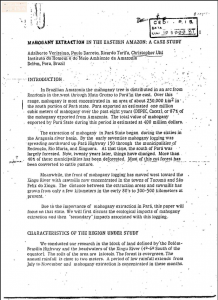| Título | Mahogany extraction in the Eastern Amazon: a case study |
| Autores | Adriana MartiniNelson Araújo Rosa
Christopher Uhl |
| Ano de publicação | 1992 |
| Download |  |
Verissimo, Adalberto; Barreto, Paulo; Tarifa, Ricardo; Uhl, Christopher. Mahogany extraction in the eastern Amazon: a case study. Belém, PA: Instituto do Homem e do Meio Ambiente da Amazônia (IMAZON), 1992. 14 p.
 Abstract
Abstract
ln Bruzilian Amazonia the mahogany tree is distributed in an arc from Rondonia in the West through Mato Grosso to Pará in the east. Over this range, mahogany is most concentrated in an area of about 250.000 km² in the sourh portion or Pará state. Para exported an estimated one million cubic meters of mahogany over thc past eight years (DEPEC, Cacex), or 87% of the mahogany exported from Amazonia. The total value of mahogany exported by Pará State during this period is estimated at 4.00 million dollars.
The extrcaction of mahogany in Pará State began during the sixties in the Araguaia river basin. By the early seventies mahogany logging was spreading northward up Pará Highway 150 through the municipalities of Redenção, Rio Maria, and Xinguar. At that time, the south of Pará was largely fIorested. Now, twenty years Iater, things have changed. More than, 40% of thesc municipalities has been deforested. Most of this cut forest has been converted to cattle pasture.
Meanwhile, the front of mahogany logging has moved west toward the Xingu River with sawmills now concentrated In the towns of Tucumá and São Felíx do Xingu. The distance between the extraction areas and sawmills has grown from only a few kilometers in the early 80 ‘s to 300-500 kilometers at present.
Due to the importance of mahogany extraction In Pará, this paper will focus on that state. We will first discuss the ecological impacts of mahogany extraction and then “secondary” impacts associated wíth this logging.
